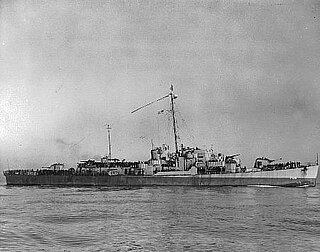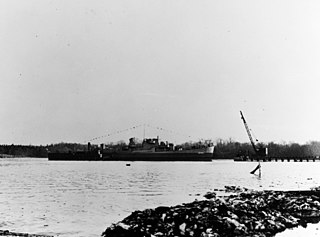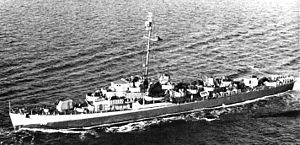
The third USS Farragut (DD-348) was named for Admiral David Glasgow Farragut (1801–1870). She was the lead ship of her class of destroyers in the United States Navy.

USS Abercrombie (DE-343) was a John C. Butler-class destroyer escort in the service of the United States Navy from 1944 to 1946. She was finally sunk as a target in 1968.

USS Kephart (DE-207/APD-61) was a Buckley-class destroyer escort in service with the United States Navy from 1944 to 1947. After spending 20 years in reserve, she was transferred to Republic of Korea Navy and served another 18 years as Kyong Puk (PF-82) until she was struck in 1985.

USS Howorth (DD-592) was a Fletcher-class destroyer built for the United States Navy during World War II.

USS Holt (DE-706) was a Rudderow-class destroyer escort of the United States Navy. She was named after William Mack Holt.

USS Lloyd (DE-209/APD-63), a Buckley-class destroyer escort of the United States Navy, was named in honor of Ensign William R. Lloyd (1916–1942).

USS Charles J. Kimmel (DE-584) was a Rudderow-class destroyer escort serving in the US Navy from 1944 through 1947. She served in both the Atlantic and Pacific theaters of World War II. Charles J. Kimmel was laid down by Bethlehem Steel in Hingham, Massachusetts on 1 December 1943 and launched on 15 January 1944. She was commissioned 20 April 1944. The vessel was decommissioned on 15 January 1947, stricken 30 June 1968 and ultimately sunk as target off California, on 13 November 1969.

USS Jaccard (DE-355) was a John C. Butler-class destroyer escort acquired by the U.S. Navy during World War II. The primary purpose of the destroyer escort was to escort and protect ships in convoy, in addition to other tasks as assigned, such as patrol or radar picket. Post-war, she returned home with one battle star to her credit.

USS Rombach (DE-364) was a John C. Butler-class destroyer escort acquired by the U.S. Navy during World War II. The primary purpose of the destroyer escort was to escort and protect ships in convoy, in addition to other tasks as assigned, such as patrol or radar picket.

USS Richard S. Bull (DE-402) was a John C. Butler-class destroyer escort in service with the United States Navy from 1944 to 1946. She was finally sunk as a target in 1969.

USS Howard F. Clark (DE-533) was a John C. Butler-class destroyer escort in service with the United States Navy from 1944 to 1946. She was sold for scrapping in 1973.

USS Mahnomen County (LST-912) was an LST-542-class tank landing ship built for the United States Navy during World War II. Like many of her class, she was not named and is properly referred to by her hull designation. She was later named after Mahnomen County, Minnesota, and was the only US Navy vessel to bear the name.

USS Thomason (DE-203) was a Buckley-class destroyer escort in service with the United States Navy from 1943 to 1946. She was scrapped in 1969.

USS Chaffee (DE-230) was a Rudderow-class destroyer escort in the United States Navy during World War II.

USS Riley (DE-579) was a Rudderow-class destroyer escort in the United States Navy during World War II. She later transferred to the Republic of China Navy and served as Tai Yuan (DE-27). The ship was finally scrapped in 1996.

USS McNulty (DE-581) was a Rudderow-class destroyer escort in the United States Navy during World War II.

USS George A. Johnson (DE-583) was a Rudderow-class destroyer escort serving with the United States Navy from 1944 to 1946. From 1946 to 1957, she was used as a Navy Reserve training ship. She was scrapped in 1966.

USS Lough (DE-586) was a Rudderow-class destroyer escort in service with the United States Navy from 1944 to 1946. She was sold for scrapping in 1970.

USS Peiffer (DE-588) was a Rudderow-class destroyer escort in service with the United States Navy from 1944 to 1946. She was sold for scrapping in 1967.

USS Tinsman (DE-589) was a Rudderow-class destroyer escort in service with the United States Navy from 1944 to 1946. She was sold for scrapping in 1973.




















